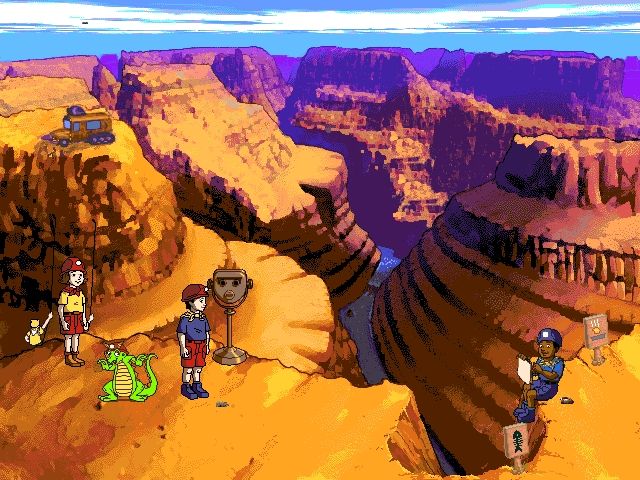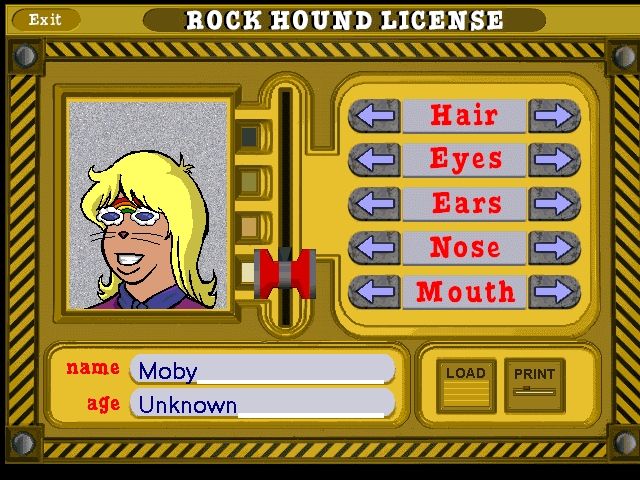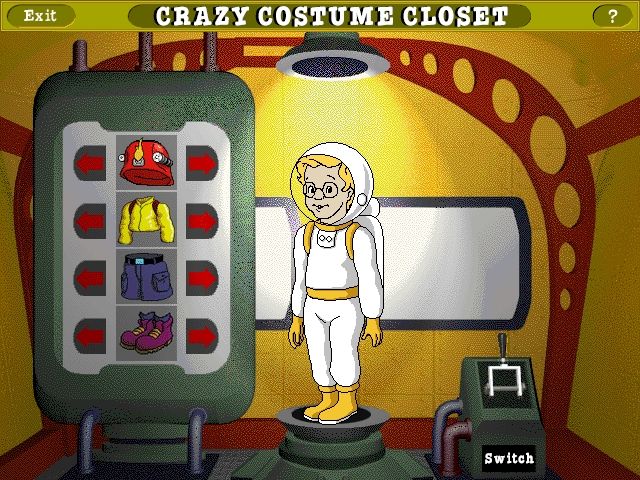Retro Replay Review
Gameplay
The Magic School Bus Explores Inside the Earth delivers an intuitive point-and-click interface that even the youngest players will find approachable. Players begin each session in the bus’s cockpit, where a simple gear shift and a prominent GO! button guide them to one of six distinct geological sites. Whether investigating the layers of the Grand Canyon, delving into a glittering geode, or riding the bus’s airplane or drilling modes, exploration remains fluid and non-linear. You can visit sites in any order, revisiting favorites at will—ideal for reinforcing scientific concepts through repetition.
(HEY YOU!! We hope you enjoy! We try not to run ads. So basically, this is a very expensive hobby running this site. Please consider joining us for updates, forums, and more. Network w/ us to make some cash or friends while retro gaming, and you can win some free retro games for posting. Okay, carry on 👍)
Beyond travel, the game’s real strength lies in its suite of hands-on activities located in the back of the bus. Here, budding geologists can perform experiments on rock specimens, dress up for themed mini-adventures, or enter the on-board kitchen to observe how heat, pressure, and gas interact with minerals. Each station is lovingly designed to model the scientific process: make a hypothesis, conduct an experiment, record results, and draw conclusions. By tying discovery to fun, the game turns abstract geology principles into memorable, interactive lessons.
On-site exploration often triggers context-sensitive minigames that blend narrative with learning. You might assemble a stratigraphic column in a cavern, decode fault line patterns to predict seismic activity, or rescue a trapped amphibian in a volcanic vent. These challenges reward curiosity: clicking on characters, signs, or rock formations can reveal additional facts, reinforce vocabulary, and even unlock bonus experiments back on the bus. This branching structure keeps players engaged and motivated to uncover every hidden nugget of knowledge.
Accountability for resources also enhances the gameplay loop. When Arnold discovers missing specimens from his collection, each successful discovery of rocks and minerals doubles as an academic victory. Tracking down replacements imparts a sense of purpose, transforming a simple treasure hunt into a structured educational quest. As children chart their geological journey, they simultaneously build research skills and critical thinking—key outcomes for any STEM-focused title.
Graphics
Visually, the game retains the charming aesthetic of Joanna Cole and Bruce Degen’s original illustrations, rendered in bright, friendly 2D artwork. The environments—from the rusty reds of the Grand Canyon to the sparkling amethyst crystals inside a geode—are richly colored and fall somewhere between cartoonish whimsy and scientific accuracy. This balance ensures that players remain captivated without losing sight of real-world geology.
Animation is smooth and purposeful. Characters move with simple, expressive gestures; rocks and minerals gleam or fracture realistically when clicked. The transitions between bus interiors and exterior scenes use quick fades, reducing downtime and preserving immersion. Occasional animated cutscenes, such as the bus transforming into a submarine undersea or a drill burrowing through bedrock, punctuate exploration with moments of delight.
The user interface is clean and unobtrusive. Icons for the drilling and airplane bus forms appear exactly when needed, and tooltips clarify each experiment or activity. The bus’s dashboard, complete with clickable knobs and levers, doubles as a workspace and compass, guiding players back to the heart of the learning experience. Even the menus are themed—mini posters featuring class members hint at additional learning resources embedded within the game’s architecture.
Overall, the visuals excel at marrying educational clarity with playful design. The intricate details in rock textures, annotated diagrams, and lab instruments make every screen an opportunity to absorb information, while the lively color palette and animated flourishes maintain the inviting tone that defines The Magic School Bus series.
Story
At its core, The Magic School Bus Explores Inside the Earth spins a simple yet effective narrative: Arnold’s rock and mineral collection has gone missing, and it’s up to the class to retrieve the specimens. Mrs. Frizzle once again dons her famously wild attire and sets the stage for a cross-continental geological expedition. This premise seamlessly integrates storyline with curriculum, giving players a clear objective wrapped in the comforting familiarity of Ms. Frizzle’s guidance.
Each site visited—be it a volcanic island chain, an underwater vent, or the twisting passages of a cavern—unfolds as a mini-chapter in the larger tale. Interactions with classmates, local wildlife, and environmental hazards pepper the journey with lighthearted banter and teachable moments. Arnold’s characteristic exclamations of worry and Ms. Frizzle’s enthusiastic reassurances serve as a narrative engine, injecting personality into what could otherwise be a rote learning exercise.
What sets this story apart is its integration of scientific inquiry into the plot. Players don’t just “collect” rocks; they learn the formation processes of igneous, sedimentary, and metamorphic specimens as part of rescuing Arnold’s treasures. Story beats—like narrowly escaping an erupting volcano or deciphering the code of a fault line—underscore the real-world importance of geology, making the educational objectives feel natural rather than forced.
The narrative pacing is well-judged for the target age group. Short missions, clear goals, and immediate feedback ensure that young learners stay on task without feeling overwhelmed by exposition. By the time the final rock is safely stowed on the bus, the game has delivered both a satisfying conclusion to Arnold’s quest and a robust foundation in Earth science principles.
Overall Experience
Scholastic’s The Magic School Bus Explores Inside the Earth succeeds as both an educational tool and a captivating adventure game. Its open-ended exploration, cleverly integrated minigames, and hands-on experiments ensure that players remain engaged from start to finish. The balance of narrative drive and free-form discovery encourages repeat visits, making it a valuable resource for classroom reinforcement or at-home learning.
While the game’s simplicity may feel dated to seasoned gamers accustomed to complex mechanics or 3D graphics, its design shines when viewed through an educational lens. Every click serves a purpose: to decode a scientific principle, to collect data, or to advance the storyline. Parents and teachers will appreciate the thorough incorporation of geology standards, while children will revel in the sense of agency as they guide the Magic School Bus to new underground frontiers.
Potential buyers should note that the game’s pacing caters best to elementary-aged audiences. Older players may find the challenges too straightforward, but younger explorers will benefit from the clear instructions and built-in support system provided by Ms. Frizzle and her class. The seamless melding of fun and learning remains the title’s greatest asset.
In sum, The Magic School Bus Explores Inside the Earth stands out as a thoughtfully crafted educational adventure. Its enduring art style, engaging gameplay loops, and well-woven narrative make it an excellent pick for families and educators seeking a quality science experience that’s as entertaining as it is informative.
 Retro Replay Retro Replay gaming reviews, news, emulation, geek stuff and more!
Retro Replay Retro Replay gaming reviews, news, emulation, geek stuff and more!









Reviews
There are no reviews yet.